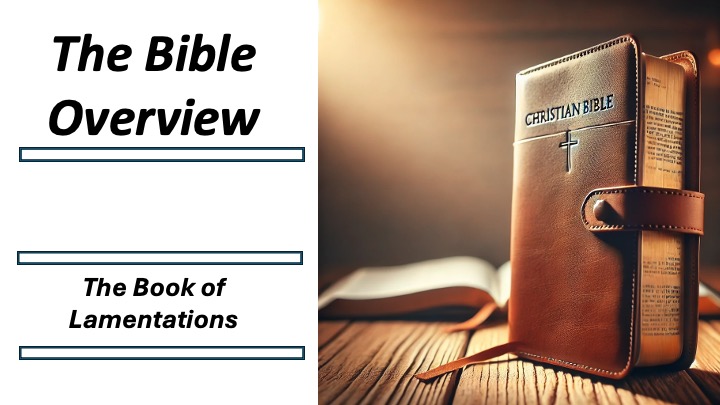Bible Overview Lamentations
Mike Ervin

Lamentations: Overview
Authorship
Traditional View:
• Traditionally attributed to Jeremiah, due to similarities in style and the
historical context of Jerusalem’s fall in 586 BC (2 Chron. 35:25).
• The Septuagint and early Jewish sources associate it with Jeremiah.
Modern Scholarly View:
• Some scholars question Jeremiah’s authorship, noting differences in style and
vocabulary from the book of Jeremiah.
• Likely written by an eyewitness of Jerusalem’s destruction (586 BC).
• May have been composed by multiple poets or a later editor compiling
pre-existing laments.
Date of Authorship
• Traditional: Shortly after 586 BC, when Jerusalem fell to the Babylonians.
• Modern Scholarship: Likely within the late 6th century BC, though some argue
for a slightly later compilation.
Intended Audience
• The exiled and suffering Israelites, mourning the destruction of Jerusalem
and seeking hope in God.
• Later readers reflecting on national tragedy and divine justice.
Major Themes
1. The Destruction of Jerusalem – The devastation caused by Babylon’s invasion.
2. God’s Judgment – Sin leads to suffering, yet God is just.
3. Suffering and Grief – Expressions of deep lament over loss and exile.
4. Hope and God’s Faithfulness – Amid suffering, God’s mercies remain (Lam.
3:22-23).
5. Call for Repentance – A plea for restoration and renewal.
Chapter-by-Chapter Summary
I. Mourning Over Jerusalem’s Fall (Chapter 1)
• Describes Jerusalem as a widow, abandoned and desolate.
• Acknowledges God’s justice in allowing destruction.
II. The Lord’s Anger (Chapter 2)
• Details the wrath of God against Judah.
• The temple’s destruction and suffering of the people.
• Calls for the people to cry out to God.
III. Hope in the Midst of Despair (Chapter 3)
• A personal lament: “I am the man who has seen affliction” (Lam. 3:1).
• Theological center: God’s mercies are new every morning (Lam. 3:22-23).
• Encouragement to wait on the Lord for restoration.
IV. The Siege and Its Horrors (Chapter 4)
• Graphic description of starvation and suffering during the Babylonian siege.
• Contrasts past glory vs. present misery.
V. Prayer for Restoration (Chapter 5)
• A national prayer of repentance and plea for mercy.
• Ends with uncertainty but a final hope in God’s faithfulness.